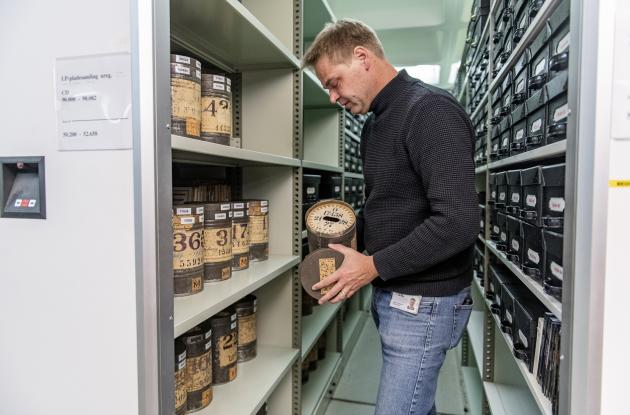Use of sound recordings
If you want to use material from Hegermann-Lindencrone's collection of sound recordings, it is important that you know about the rights of the material.

Photo: Thomas Søndergaard
The material is primarily just for listening in the Research reading room. If you need to use parts of the material in connection with an exhibition or publication, make sure that all rights are cleared.
Step 1 - the actual sound recording
We recommend that you first find the recordings that you are interested in using by listening to the material at the Research reading room in The Black Diamond, Copenhagen.
Once you have clarified which parts of the audio archive you are interested in using, you can start the work of clearing rights.
Step 2 - rights to the actual sound recording
If the sound recording is still protected by copyright, we may not provide you with a digital copy unless you have obtained the consent of the rights holder or their heirs, or have otherwise cleared the rights.
Especially for these sound recordings, there are many types of rights that you need to be aware of.
- The producer of the sound recording has rights to the recording for 50 years from time of the recording. If the sound recording is released, the copyright lasts 70 years from its first release. The distribution company Hegermann-Lindencrone has regularly distributed material from the collection, so you can find out more on their website.
- Composers and playwrights have rights to their works for 70 years after their death.
- The performers have rights to the performance of the works for 50 years from the first performance.
Step 3 - user clears rights and submits documentation
We can provide digital recordings from the audio archive for full rights clearance, that is obtaining consent from ALL involved; the sound recording artists, composers, playwrights, performers and any others who have been co-creators of the performance or concert being recorded. If one of several rights holders of a work does not want to give consent, we respect this and the material will not be handed out.
You must obtain the consent of the artist yourself before we can hand over a digital copy or allow analogue copies to be made. We can help you with information from the metadata about the artist or heirs, if we have this information.
It is your responsibility to clear copyright. Anyone who chooses to use someone else's work is responsible for their own use.
You can choose to obtain permits from the individual right holders or their heirs. But it can be a difficult task, and instead we can refer you to contact the relevant rights organisation, for example KODA, the Danish Composers' Society or Copydan Tekst & Node, and others to hear if you can make an agreement. We require written documentation that all rights have been cleared before we can release copyrighted sound recordings.
Requirements for consent:
- The consent must be in writing. In very simple cases it can be an email.
- The consent must contain a clear indication of what the artist gives his consent to and any conditions, including, for example, fees.
- Some works have several artists. This applies, for example, to musical works, books and articles. In these cases, the consent of ALL of them must be obtained before we can hand over the material.
Step 4 - Crediting of all rights holders and information about Royal Danish Library
In connection with the use of the material, ALL right holders must be credited. Also when the copyright has expired.
We also encourage you to note that Hegermann-Lindencrone's collection is owned by Royal Danish Library.